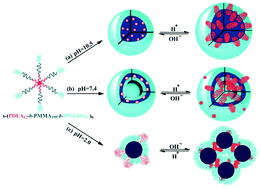Self-assemblies of the six-armed star triblock ABC copolymer: pH-tunable morphologies and drug release†
Abstract
We herein report a well-defined six-armed star triblock copolymer poly(2-(diethylamino)ethyl methacrylate)-b-poly(methyl methacrylate)-b-poly(poly(ethylene glycol) methyl ether methacrylate) (s-(PDEA62-b-PMMA195-b-PPEGMA47)6) that was synthesized by the core-first ATRP (atom transfer radical polymerization) method. The star triblock copolymer has low critical aggregation concentration (CAC) values in aqueous solutions (0.78–2.5 mg L−1) and shows pH-tunable self-assembly behavior. It could self-assemble into multicompartment micelles at pH 10.5, vesicles at pH 7.4 and micelles at pH 2.0. Regardless of micelles or vesicles, their hydrodynamic diameter (Dh) could respond to the change in environmental pH. Interestingly, the reversible vesicle–micelle transition could be achieved via simply adjusting the surrounding pH. The transition was a result of PDEA moieties being responsive to the pH change instead of reassembly. Using the hydrophobic drug celecoxib as a model guest molecule, loading capacities of the star copolymer aggregates under the above-mentioned three pH conditions and the influence of the presence of the guest molecules on the morphology of the aggregates were investigated. It was found that loading capacities of the star copolymer were 33–35 wt% (relative to the polymer) at pH 7.4, 26–28 wt% at pH 10.5 and 10–15 wt% at pH 2.0, and at pH 7.4, incorporation of 33 wt% celecoxib did not change the morphology of vesicles evidently. However, at pH 10.5, the presence of 26 wt% celecoxib could lead to self-assembly of the star copolymer into vesicles. The celecoxib release from the loaded self-assemblies is pH tunable.


 Please wait while we load your content...
Please wait while we load your content...